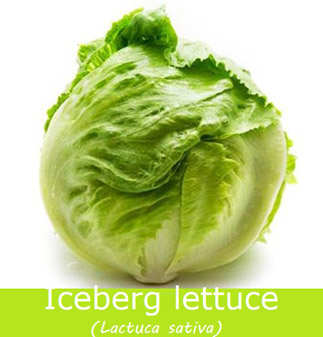Iceberg lettuce nutrition facts
Iceberg lettuce is the most popular head lettuce type consumed in the US. Also known as crisphead, it is characterized by a tight head of crisp, outer light green leaves, with more light-yellow or white leaves at the center.
Scientific name: Lactuca sativa var. capitata. Its crispy textured and neutral taste greens are a popular addition to salad mixes.
 |
Iceberg lettuce is a cool-season crop, that prefers fertile, moisture-rich sand and loamy soil types.
In the US, California is the leading iceberg lettuce-producing state, where it is grown in the desert climates of the Southwest during the winter months and along the central coastal regions, especially in Salinas Valley, during the rest of the year.
Iceberg lettuce is considered the mildest of the lettuce varieties. It comes in tight, dense heads similar to cabbage. Spring crops mature in less than 90 days, while fall crops require about 120 days to harvest.
Iceberg lettuce size ranges from 20-25 centimeters in diameter and is spherical in shape, similar to cabbage.
After the harvest, the lettuce heads are cooled, washed, and precut into various types of retail packages for supply to food service agencies like restaurants, institutions, airlines, and schools.
Health benefits of Iceberg lettuce
At 14 calories/100g, Iceberg lettuce carries the lowest calories among all lettuce varieties. Nonetheless, it is the storehouse of many phytonutrients that possess health-promoting and disease-prevention properties.
It is also a less nutrient-dense lettuce type. However, its crispy, firm leaves hold a lot of moisture and fiber which help in the smooth digestion and prevention of constipation.
Icerberg lettuce is plentiful in vitamins such as folates, vitamins A, C, and K, and small amounts of minerals such as manganese, iron, and calcium.
It is a rich source of vitamin-K, 24.1 µg/100g. Vitamin K has a potential role in bone metabolism where it thought to increase bone mass by promoting osteoblastic activity in the bone cells. It also has an established role in the Alzheimer's disease patients by limiting neuronal damage in the brain.
Fresh leaves contain good amounts folates and vitamin C. Folates are part of co-factors in the enzyme metabolism required for DNA synthesis and therefore, play a vital role in the prevention of neural tube defects in the baby (fetus) during pregnancy.
Vitamin C is a powerful natural antioxidant; regular consumption of foods rich in vitamin C helps the body develop resistance against infectious agents and scavenge harmful, pro-inflammatory free radicals.
Its fresh leaves are an excellent source of several Vitamin-A and β-carotenes. Just 100 g of fresh, raw-Icerberg lettuce provides 17% daily values of vitamin-A and 299 µg of β-carotene (Carotenes convert into vitamin-A inside the human body; 2 µg of carotene is considered equivalent to 1 IU of vitamin-A). These compounds possess strong antioxidant properties. Vitamin A is required for maintaining healthy mucosa and skin and is also essential for vision. Consumption of natural fruits and vegetables rich in flavonoids helps to protect the body from lung and oral cavity cancers.
It also contains healthy amounts of minerals like iron, calcium, magnesium, and potassium, which are very much essential for body metabolism. Potassium is an important component of cells and body fluids that helps control heart rate and blood pressure. The body uses manganese as a co-factor for the antioxidant enzyme, superoxide dismutase. Copper is required in the production of red blood cells. Iron is essential for red blood cell formation.
It is rich in the B-complex group of vitamins like thiamin, vitamin B-6 (pyridoxine), and riboflavin.
Dieticians often recommend the consumption of iceberg lettuce in cholesterol reduction and weight management programs.
Regular inclusion of Icerberg lettuce in the diet is known to prevent osteoporosis, iron-deficiency anemia, and believed to protect from cardiovascular diseases, ARMD, Alzheimer's disease and cancers.
| Principle | Nutrient Value | Percent of RDA |
|---|---|---|
| Energy | 14 Kcal | <1% |
| Carbohydrates | 2.97 g | 2.3% |
| Protein | 0.9 g | 1.6% |
| Total Fat | 0.14 g | 0.7% |
| Cholesterol | 0 mg | 0% |
| Dietary Fiber | 1.2 g | 3% |
| Vitamins | ||
| Folates | 29 µg | 7.5% |
| Niacin | 0.123 mg | <1% |
| Pantothenic acid | 0.091 mg | 2% |
| Pyridoxine | 0.042 mg | 3% |
| Riboflavin | 0.025 mg | 2% |
| Thiamin | 0.041 mg | 3.5% |
| Vitamin A | 502 IU | 16.7% |
| Vitamin C | 2.8 mg | 3% |
| Vitamin E-α | 0.18 mg | 1.2% |
| Vitamin K | 24.1 µg | 20% |
| Electrolytes | ||
| Sodium | 10 mg | <1% |
| Potassium | 141 mg | 3% |
| Minerals | ||
| Calcium | 18 mg | 1.8% |
| Copper | 0.025 mg | 3% |
| Iron | 0.41 mg | 5% |
| Magnesium | 7 mg | 1.75% |
| Manganese | 0.125 mg | 5% |
| Phosphorus | 20 mg | 3% |
| Zinc | 0.15 mg | 1.4% |
| Phyto-nutrients | ||
| Carotene-ß | 299 µg | -- |
| Crypto-xanthin-ß | 0 µg | -- |
| Lutein-zeaxanthin | 277 µg | -- |
Selection
Fresh, whole crispheads wrapped in cellophane or precut salad in air-seal packs are available in supermarkets and groceries around the year.
Choose iceberg lettuce featuring a fresh, round, firm head with no discoloration on the outer leaves. Avoid spongy or soft; freeze-injury, burst, or misshapen heads. Also, pass over any lettuce with limp, bruised, or yellowing leaves.
Storage and Handling
Iceberg lettuce has longer storage capabilities than other lettuce varieties; however, it is less flavorful when compared to romaine lettuce.
Store iceberg head at the home refrigerator in perforated plastic bags wrapped in damp paper towels and keep it in the vegetable crisper for up to five to seven days.
Keep lettuce away from fruits or vegetables that emit a lot of ethylene, as this gas leads to brownish discoloration of leaves. Make it crispier by plunging in cold water.
Preparation and serving methods
Crisphead lettuce has an excellent texture and will keep its vitality long. Remove any discolored outer leaves. Then trim off their bitter tips.
Rinse leaves in a colander with cold water to remove surface dirt/sand. Remove excess moisture after washing by patting leaves dry.
Chop the remaining leaf to your desired size and discard the tough stem/root portion.
The best lettuces are those picked fresh from the garden. Eat as soon as possible after purchase.
 |
| Iceberg lettuce-tomato salad. Photo: Omid Tavallai |
Here are some serving tips:
Iceberg lettuce is most often eaten raw, but it can also be cooked.
Raw lettuce is mainly served as a salad, dressed with vinaigrette or mayonnaise, or used in sandwiches and burgers.
Combining several varieties of lettuce in a salad improves its look, flavor, and nutritional value. It is often braised or used in soups.
Finely shredded lettuce leaves added to a soup at the end of the cooking time add a delicate flavor to the broth. Pureed lettuce leaves also make an excellent soup.
Safety profile
Crisphead lettuce is highly susceptible to contamination by foodborne pathogens such as E.coli and Salmonella.
Always buy fresh lettuce from authentic sources and discard produce that doesn't comply with US-FDA safety guidelines. (Medical disclaimer).
Also read ≻≻-
≻≻- Lettuce nutrition facts.
≻≻- Lamb's lettuce (Mâche) nutrition facts.
≻≻- Stem-lettuce (Celtuce) nutrition facts.
≻≻-Back to Vegetables from Iceberg lettuce. Visit here for an impressive list of vegetables with complete illustrations of their nutrition facts and health benefits.
≻≻-Back to Home page.
Further Resources:
Iceberg lettuce production in California- UC Vegetable Research & Information CenterVegetable Production Series. (Link opens in new window).
Watch your garden grow, University of Illinois Extension. (Link opens in new window).
Lactuca sativa var. capitata- Food Source Information (Link opens in new window).